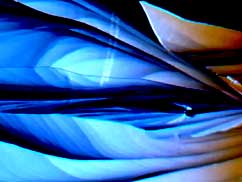Chemical Crystal Movie Gallery
Bromo-Succinimide Time Lapse Sequences
Used by the pharmaceutical and chemical industries as an intermediary, N-bromosuccinimide serves as an oxidizing agent in the synthesis of drugs and hormones. For isolating rare elements in the laboratory or on an industrial scale, N-bromosuccinimide is utilized as an extraction solvent.

N-bromosuccinimide (NBS) is characterized by a molecular weight of 177.99, a chemical composition of 4 carbon, 4 hydrogen, 1 bromine, 1 nitrogen, and two oxygen atoms per molecule, and a faint bromine odor. Appearing as an off-white powder, N-bromosuccinimide melts between 173 and 176 degrees Celsius, and is soluble in acetone and slightly soluble in water. Alternatively, bromosuccinimide is known to biochemists as 1-bromo-2,5-pyrolidinedione or succinibromide. For the laboratory synthesis of NBS, succinimide is dissolved in a solution of sodium hydroxide, ice, and water, then bromine is added, and the N-bromosuccinimide is filtered out as a precipitate. In chemical production processes, bromopyrolidinedione is used to brominate alkenes at the allylic position, and as a mild and efficient catalyst for converting carbonyl compounds by diethyl- and cyclic acetalization.
As a hazardous chemical, N-bromosuccinimide is harmful if swallowed, inhaled, or absorbed through the skin, and can cause severe irritation to skin, eyes, and the respiratory tract. Decomposition products include oxides of nitrogen and carbon, and hydrogen bromide. Because many reactions involving N-bromosuccinimide are extremely exothermic, including violent or explosive reactions with aniline, diallylsulfide, hydrazine, and propiononitrile, special care is necessary for storage and handling. Heating NBS leads to cleavage of the molecule, and the production of a highly reactive free radical, plus bromine gas.
Bromo-Succinimide Time Lapse Sequence #1 - In a 29-image time-lapse sequence, dendritic crystals exhibiting a brilliant blue interference color grow across the viewfield from the lower right-hand corner to the upper left.
Bromo-Succinimide Time Lapse Sequence #2 - A continuous sheet-like crystalline layer grows across the viewfield from the lower right to the upper left-hand corner in a time-lapse sequence of 28 individual images.
Bromo-Succinimide Time Lapse Sequence #3 - Crystals growing across the viewfield from right to left exhibit a feather-like appearance in this sequence made up of 31 images.
Bromo-Succinimide Time Lapse Sequence #4 - This 27-image time-lapse sequence illustrates the growth of fan-like crystal forms that radiate from the lower left-hand corner toward the upper right-hand corner of the microscope viewfield.
Bromo-Succinimide Time Lapse Sequence #5 - Crystallization occurs from a number of growth sites and progresses radially throughout the viewfield in this time-lapse sequence of 22 images.
Bromo-Succinimide Time Lapse Sequence #6 - In this 16-image time-lapse sequence, crystallization advances outward from two nucleation sites, continuing until the viewfield is filled.
Bromo-Succinimide Time Lapse Sequence #7 - In this time-lapse sequence of 43 images, crystallization fronts advancing from diagonally opposite corners of the viewfield appear to have spherulitic and dendritic characteristics.
Contributing Authors
Omar Alvarado, Thomas J. Fellers and Michael W. Davidson - National High Magnetic Field Laboratory, 1800 East Paul Dirac Dr., The Florida State University, Tallahassee, Florida, 32310.
BACK TO THE CHEMICAL CRYSTAL MOVIE GALLERY
BACK TO THE DIGITAL IMAGE GALLERIES
Questions or comments? Send us an email.
© 1995-2025 by Michael W. Davidson and The Florida State University. All Rights Reserved. No images, graphics, software, scripts, or applets may be reproduced or used in any manner without permission from the copyright holders. Use of this website means you agree to all of the Legal Terms and Conditions set forth by the owners.
This website is maintained by our
Graphics & Web Programming Team
in collaboration with Optical Microscopy at the
National High Magnetic Field Laboratory.
Last Modification Friday, Nov 13, 2015 at 01:19 PM
Access Count Since September 17, 2002: 18989
Visit the website of our partner in introductory microscopy education:
|
|
